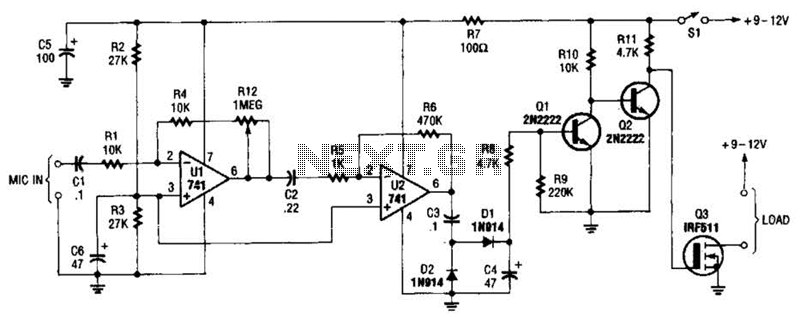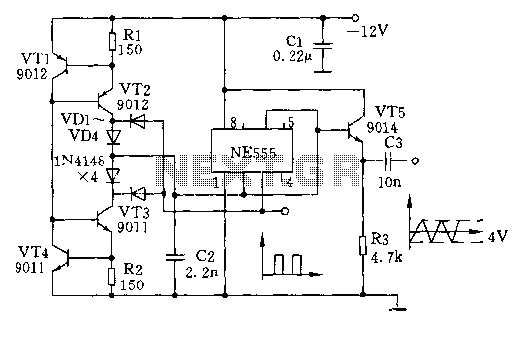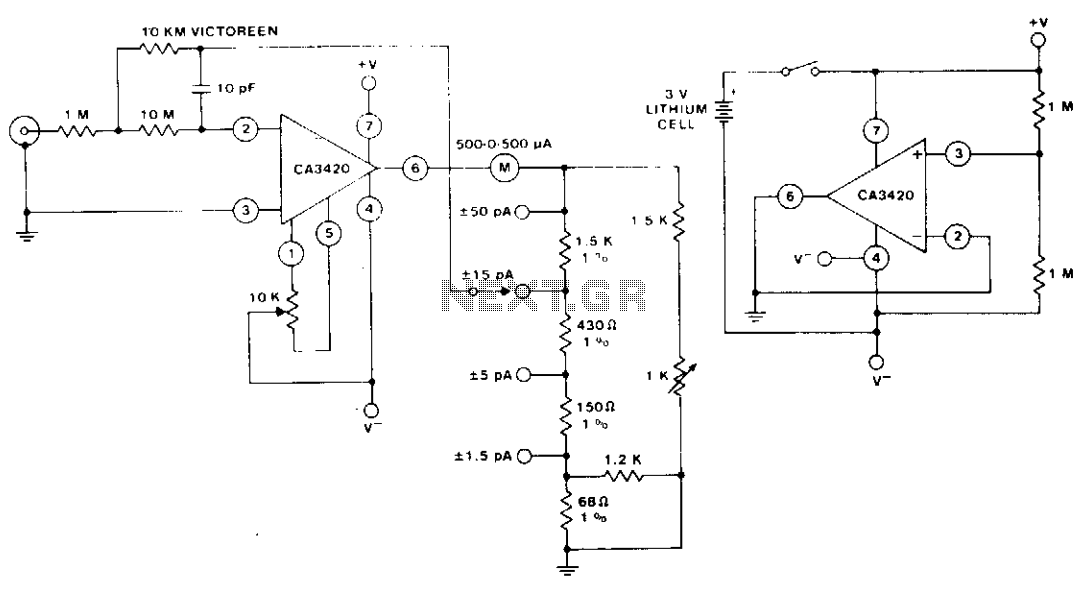
Audio Controlled Switch Circuit

The audio-controlled switch utilizes a pair of 741 operational amplifiers, two 2N2222 general-purpose transistors, a hexFET, and several supporting components to create a circuit capable of activating devices such as a tape recorder, a transmitter, or virtually any other sound-activated equipment.
The audio-controlled switch circuit is designed to respond to audio signals, allowing it to activate various devices based on sound input. The core of the circuit consists of two 741 operational amplifiers configured as a comparator. The first op-amp is used to amplify the audio signal, while the second op-amp compares the amplified signal to a predetermined threshold level. If the audio signal exceeds this threshold, the output of the second op-amp transitions from low to high.
This high output from the second op-amp is used to drive the base of the first 2N2222 transistor, which acts as a switch. When the transistor is activated, it allows current to flow from the power supply to the gate of the hexFET. The hexFET, being a type of MOSFET, is controlled by the voltage at its gate and can handle higher power loads, making it suitable for driving larger devices like tape recorders or transmitters.
The second 2N2222 transistor serves as a buffer, ensuring that the op-amp output can effectively drive the gate of the hexFET without loading down the op-amp circuit. Additional supporting components, such as resistors and capacitors, are included to stabilize the circuit and filter any noise from the audio signal. A diode may also be used to protect the circuit from back EMF generated by inductive loads.
Overall, this audio-controlled switch circuit provides a versatile solution for sound-activated applications, enabling users to control a wide range of devices with audio signals. Proper component selection and configuration are essential to ensure reliable operation and responsiveness to audio inputs. The audio-controlled switch combines a pair of 741 op amps, two 2N2222 general-purpose transistors, a hexFET, and a few support components to a circuit that can be used to turn on a tape recorder, a transmitter, or just about anything that uses sound.
The audio-controlled switch circuit is designed to respond to audio signals, allowing it to activate various devices based on sound input. The core of the circuit consists of two 741 operational amplifiers configured as a comparator. The first op-amp is used to amplify the audio signal, while the second op-amp compares the amplified signal to a predetermined threshold level. If the audio signal exceeds this threshold, the output of the second op-amp transitions from low to high.
This high output from the second op-amp is used to drive the base of the first 2N2222 transistor, which acts as a switch. When the transistor is activated, it allows current to flow from the power supply to the gate of the hexFET. The hexFET, being a type of MOSFET, is controlled by the voltage at its gate and can handle higher power loads, making it suitable for driving larger devices like tape recorders or transmitters.
The second 2N2222 transistor serves as a buffer, ensuring that the op-amp output can effectively drive the gate of the hexFET without loading down the op-amp circuit. Additional supporting components, such as resistors and capacitors, are included to stabilize the circuit and filter any noise from the audio signal. A diode may also be used to protect the circuit from back EMF generated by inductive loads.
Overall, this audio-controlled switch circuit provides a versatile solution for sound-activated applications, enabling users to control a wide range of devices with audio signals. Proper component selection and configuration are essential to ensure reliable operation and responsiveness to audio inputs. The audio-controlled switch combines a pair of 741 op amps, two 2N2222 general-purpose transistors, a hexFET, and a few support components to a circuit that can be used to turn on a tape recorder, a transmitter, or just about anything that uses sound.





